|
|
Congratulations to Our 2008 Recovery Champions!
Recovery Champions are U.S. Fish and Wildlife Service staff and their partners whose work is advancing the recovery of endangered and threatened species of plants and animals in the United States.
|
| Region 1 |
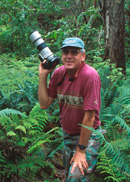 |
Jack Jeffrey
U.S. Fish and Wildlife Service
Akiapolaau, alala (Hawaiian crow), Hawaii akepa, Hawaii creeper, nene (Hawaiian goose), palila, Hawaiian hoary bat, and haha plant
A noted photographer and conservationist, Jack Jeffrey has worked to benefit Hawaiian forestlands and endangered and threatened species that are found nowhere else. On the Hakalau Forest National Wildlife Refuge, he has led 1,600 volunteers in planting more than 300,000 koa trees and native shrubs and removed invasive species, making the refuge a world-class site for protecting Hawaii’s natural heritage. Directing his camera toward the wildlife and plants that he loves, Jack Jeffrey’s photos have appeared in Audubon, Smithsonian, TIME, and LIFE, focusing on the ‘akiapōlā‘au, ‘alala, Hawai‘i ‘ākepa, Hawai‘i creeper, nēnē, palila, Hawaiian hoary bat, and the haha plant.
|
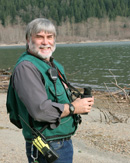 |
Dwayne K. Paige, Ph.D.
Seattle Public Utilities
Bull trout
In connection with the Cedar River Watershed Habitat Conservation Plan, Dr. Dwayne Paige’s bull trout research has evolved into one of the region’s most comprehensive studies of the species and its prey in a reservoir-tributary system, particularly important in a changing climate since Seattle Public Utilities supplies drinking water for 1.4 million people. Working with project managers to ensure water supply projects are protective of the bull trout and its ecosystem, Dr. Paige has improved habitat by designing stream restorations, stream crossings, and road decommissioning. On a regional level, Dr. Paige’s participation on the bull trout recovery team has advanced a plan for adfluvial populations, such as those in the Cedar River watershed.
|
| Region 2 |
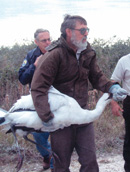 |
Tom Stehn
U. S. Fish and Wildlife Service
Whooping crane
Tom Stehn, national whooping crane recovery coordinator, has charted a strategy to ensure that the species endures as a national treasure. Guardian of the only wild migratory flock, Tom has achieved impressive results in restoring whooping cranes to the landscape that they once occupied in scattered areas from Canada to Mexico, increasing their numbers from 87 in 1982 to more than 350 in 2008, including 270 at Aransas National Wildlife Refuge. He has also established populations in Wisconsin and Florida, implemented the ultralight aircraft technique, and increased public awareness. Now focusing on protecting essential salt marsh habitat on the Texas coast, Tom has engaged a variety of partners, including international organizations.
|
 |
Jackie Poole
Texas Parks and Wildlife Department
Texas wild-rice, Tobusch fishhook cactus, Texas snowbell, star cactus, and
Texas poppy-mallow
Jackie Poole is accomplished in research, management, and outreach activities for endangered plant species, including Texas wild rice, Tobush fishhook cactus, Texas snowbell, Texas star cactus, and Texas poppy-mallow. The South-Central regional coordinator for The Flora of North America, Jackie Poole was the lead author for the book, Rare Plants of Texas. She has complemented scholarship with hands-on work, obtaining permission for surveys on private land, documenting the decline of plants on state parks and near highways, and enrolling volunteers to conduct surveys and enter information into a GIS application to limit development impacts along the San Marcos River.
|
| Region 3 |

|
Karner Blue Butterfly Team-Wisconsin
Cathy Carnes and Mike Engel
U.S. Fish and Wildlife Service
Karner blue butterfly
The Fish and Wildlife Service’s Karner Blue Butterfly Team-Wisconsin is a Recovery Champion for its work on behalf of this endangered species. Cathy Carnes’ interpersonal skills and energy resulted in the Statewide Habitat Conservation Plan for the Karner blue on 7 million acres in Wisconsin. This HCP is a national model for planning and partnerships, pioneering a flexible approach that protects small private landowners through commitments by private timber companies, utility companies, county forests, and conservation organizations. By engaging private landowners, Mike Engel completed more than 200 projects that restored 6,500 acres of habitat for the species. As a true measure of commitment, when discussions began on renewing the HCP the partners embraced recovery of the Karner blue butterfly as their goal!
|
 |
Dr. Francesca Cuthbert
University of Minnesota
Piping plover
When many people thought the population was destined for extinction, Dr. Francesca Cuthbert continued to work toward recovery of the endangered population of Great Lakes piping plovers. Now after more than 20 years of work, her leadership, innovation, and determination have been key factors in accounting for the highest number in the population since its listing! Dr. Cuthbert’s banding initiative has provided important information on the distribution of the birds in the summer and on their wintering grounds. Her work determining breeding habitat requirements, dispersal patterns, and migratory routes was essential in the final critical habitat designation. Dr. Cuthbert pioneered the surrogate species technique, salvaging abandoned eggs and young for captive-rearing. Her nest protection methods have improved hatchling success, fledgling success, and juvenile survival.
|
| Region 4 |
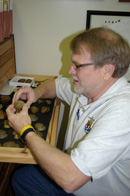 |
Leroy Koch
U. S. Fish and Wildlife Service
Ring pink mussel, purple cat’s paw mussel, and white cat’s paw and mussel
Leroy Koch’s opinions on mussel recovery are well respected throughout the Fish and Wildlife Service. At the invitation of the Great Lakes-Big Rivers Region, Leroy Koch serves on the Purple Cat’s-paw Recovery Team. Leroy is similarly engaged in mussel work for the Northeast Region. A long-time member of the Freshwater Mollusk Conservation Society, he has provided direction for mussel recovery throughout the Ohio River Valley. Leroy has led priority actions for some of the most critically endangered species, including the ring pink. His experience in developing propagation techniques has resulted in the discovery of host fishes. It has also spurred research into mussel life-history and an emerging technique that allows juveniles of common species to be grown in vitro via an artificial medium instead of a host fish!
|
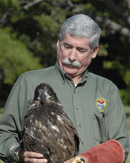 |
Tom Murphy
South Carolina Department of Natural Resources
Bald eagle, brown pelican, wood stork, American alligator, loggerhead sea turtle and other sea turtle species
Tom Murphy’s Recovery Champion award honors his work with endangered species—American alligators, bald eagles, brown pelicans, wood storks, and loggerhead sea turtles. Tom’s career features a range of “firsts” that speak to his capabilities. He was the first non-game biologist hired by the South Carolina Department of Natural Resources, setting up an office in Green Pond in 1976 and focusing on coastal species. Tom was the leader of the first Bald Eagle Recovery Team in the Southeast. He was the first person to track loggerhead sea turtles using sonic and radio telemetry, and the first to document wood stork nesting in South Carolina. Tom invented “trip snares” for alligators and “float shoes” to survey wading bird rookeries.
|
| Region 5 |
 |
Barbara Douglas
U. S. Fish and Wildlife Service
Indiana bat and endangered mussel species
Barbara Douglas’ ability to engage people in action is having widespread benefits for endangered species in West Virginia. With the help of partners, Barb completed a multi-year, 100-mile mussel survey of the Elk River, identifying threats, mapping habitat types, and focusing on areas for protecting and augmenting mussel beds. Through an Ohio River Basin partnership, she is working to conserve fish and mussels, including three listed species, with the goal of establishing a joint venture under the National Fish Habitat Action Plan. Responding to the threat of white-nose syndrome in bats, Barb has surveyed for the syndrome, worked with landowners to close caves, developed decontamination procedures for caving gear, and addressed 2,000 cavers at a national convention. She led a group that constructed a bat gate at Trout Cave, a priority hibernaculum for endangered Indiana bats and other species.
|
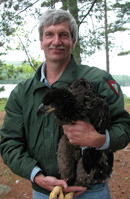
|
Charles Todd
Maine Department of Inland Fisheries and Wildlife
Bald eagle
A “veritable institution” in Maine, Charles Todd is noted for his bald eagle work in the skies and on the ground—spotting habitat, protecting nest sites, rearing chicks, banding nestlings, rescuing injured birds, and providing eagles to other states to establish populations. Applauded for his diplomatic approach and technical expertise, Charles has collaborated with Native American tribes, pulp and paper mills, the academic community, non-government organizations, and state and federal agencies, engaging landowners to ensure that nesting birds were safe from disturbance. He has given presentations to schools, universities, conservation groups, and scientists—and helped establish Maine’s first eagle Webcam. On his watch, Maine’s bald eagle population has increased from 41 nesting pairs in 1976 to 477 nesting pairs in 2008.
|
| Region 4 & 5 |
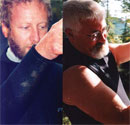 |
Conservation Fisheries, Inc.
J. R. Shute and Pat Rakes, Co-directors
Conasauga logperch, smoky madtom, yellowfin madtom, blue shiner, Cape Fear shiner, slender chub, blackside dace, boulder darter, vermillion darter, spotfin chub, and other endangered fish species
Since the 1980s, J. R. Shute and Pat Rakes have worked to recover more than 50 of the rarest fishes in Tennessee, Alabama, Georgia, Kentucky, Virginia, Mississippi, Arkansas, and North Carolina. Their organization, Conservation Fisheries, Inc., has developed propagation protocols and technologies for fish-rearing, restored populations in their native streams—and expanded the knowledge of spawning behavior, habitat preferences, larval development, and early life-stage environmental sensitivity. Along with producing host fishes for freshwater mussels and maintaining “ark” captive populations, Conservation Fisheries has saved the smoky madtom from extinction, enhanced the status of species such as the yellowfin madtom, moved several species closer to delisting, and precluded the need to list others.
|
| Region 6 |
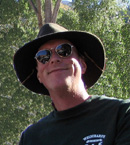 |
Mark Butler
U. S. Fish and Wildlife Service
Whooping crane, interior least tern, piping plover, and pallid sturgeon
Dedicated to Platte River habitat issues in Nebraska since the 1980s, Mark Butler worked to help endangered and threatened species, especially the whooping crane, interior least tern, piping plover, and pallid sturgeon. Mark began his involvement as chief hydrologist, assisting in mitigation actions for a reservoir and irrigation project. Then he worked with stakeholders throughout the river basin on the Platte River Recovery Program. In partnership with Colorado, Wyoming, and Nebraska, water user representatives, the Bureau of Reclamation, and environmental organizations, the program promises real progress in habitat recovery. With the same stakeholders, Mark helped formulate legislation that became law and authorized $157 million in Federal cost-share funds. Progress is already evident with a record number of whooping cranes on the Platte River and terns and plovers in reaches where they have not been for years!
[Editor’s note: Mark Butler died unexpectedly in June 2008 while engaged in the conservation work that he loved.]
|
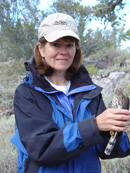 |
Elaine York
The Nature Conservancy, Utah
Dwarf bear poppy, Holmgren milk-vetch, Shivwits milk-vetch, and Siler pincushion cactus
Elaine York’s work on behalf of endangered and threatened plant species has focused attention on the need for planning to ensure a healthy ecosystem for fish, wildlife, and plants—and people. Elaine has promoted awareness of the importance of conserving plants and has engaged partners in initiatives such as acquiring the White Dome Nature Preserve to safeguard biodiversity. Among the species that have benefited from her work are the dwarf-bear poppy, Holmgren milk-vetch, Shivwits milk-vetch, and Siler pincushion cactus. Her outreach success is evidenced by the Mayor of St. George’s proclamation of “Dwarf-bear Poppy Day” in appreciation for one of Utah’s natural treasures. Elaine’s leadership in the public planning process in Washington County, Utah has engaged partners in protecting sensitive areas by identifying, creating, and maintaining three preserves.
|
| Region 7 |
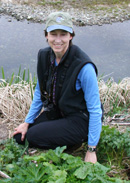 |
Karen Laing
U. S. Fish and Wildlife Service
Spectacled eider and Steller’s eider
Leading the recovery program for Steller’s eiders and spectacled eiders in Alaska,
Karen Laing has engaged partners inside and outside the Fish and Wildlife Service. Karen has worked closely with the Alaska SeaLife Center, an essential partner in many aspects of the recovery program. Working with the oil and gas industry and the National Fish and Wildlife Foundation, Karen has obtained and leveraged funding to facilitate interagency coordination on research for spectacled eiders in the Chukchi Sea. The new information will accomplish high priority recovery tasks such as evaluating and predicting the effects of environmental change in marine habitats and guide regulatory actions related to energy development in the region. Karen’s energy has invigorated conservation initiatives for the species, and ongoing progress is attributable to her dedication.
|
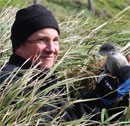 |
Dr. Paul Sievert
USGS, University of Massachusetts, Cooperative F&W Research Unit
Short-tailed albatross
As a founding member of the Short-tailed Albatross Recovery Team, Dr. Paul Sievert has been applauded for his leadership and involvement in albatross recovery efforts. Dr. Sievert has been the eyes, ears, and scientific expert for the U.S. Fish and Wildlife Service on recovery initiatives for the species in Japan and the United States. He has been cited for his “incredible positive attitude, coupled with indisputable expertise in albatross biology and mastery of field techniques.” He has traveled to Torishima Island and engaged in satellite-tagging the birds. Dr. Sievert’s skills enabled the recovery team to model different scenarios, ultimately generating a consensus on measurable and defensible draft and final recovery criteria. Since he began his work, the global population of the short-tailed albatross has increased at a remarkable 7 percent per year!
|
| Region 8 |
 |
Nadine Kanim
U. S. Fish and Wildlife Service
Yreka phlox
Nadine Kanim’s ability to bring people together in a shared mission has helped to ensure that the Yreka phlox, a plant listed as endangered under both state and federal law, continues as a part of our natural heritage. She has engaged partners who have permanently protected from development four parcels of land representing more than 60 percent of occupied habitat on China Hill. Her enthusiasm is contagious and has generated enrollment in the recovery team. The group has focused on removing the threat of land development and herbicide applications, involving the California Department of Transportation, U. S. Forest Service, Timber Products Company, Fruit Growers Supply Company, and private landowners. Surveys on more than 1,300 acres, now protected from development and unrestricted herbicide application, have located additional populations of the Yreka phlox.
|
 |
Dr. Patrick Kelly
California State University, Stanislaus
Riparian brush rabbit
Dr. Patrick Kelly is a Recovery Champion for his work in conserving riparian brush rabbits. His leadership in recovering this species is particularly notable in that after the 1997 Central Valley floods there was concern that riparian brush rabbits no longer existed. Dr. Kelly has been applauded for his “watchful eye, passionate commitment, scrupulous focus and leadership.” His work has included capturing animals for a propagation program, health-checking the young, radio-collaring and tagging, releasing into the wild, and then monitoring the rabbits for survival, healthy reproduction, and habitat use. Dr. Kelly has introduced riparian brush rabbits onto the San Joaquin National Wildlife Refuge and adjacent private land. He has saved the riparian brush rabbit from the brink of extinction and transported it to the road to recovery.
|
| Region 9 |
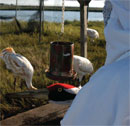 |
Whooping Crane Eastern Partnership Outreach Team
Joan Garland and Daniel Peterson, Co-chairs
Whooping crane
The Whooping Crane Eastern Partnership Outreach Team has promoted awareness of the introduced flock of whooping cranes that were trained, when young, to “adopt” an ultralight aircraft and follow the plane from Necedah National Wildlife Refuge in central Wisconsin to St. Mark’s National Wildlife Refuge in Florida. Co-chaired by Joan Garland and Daniel Peterson, the outreach team works with the media, gives presentations at schools in the seven-state region, staffs information booths at birding festivals, and keeps current a Web site, “Journey North,” that maintains a chronology of the migrations and receives more than 7 million “hits” a year! Providing insurance against extinction, this flock complements the one that naturally migrates between the Texas coast and Canada.
|
Information on 2007 Recovery Champions
Information on 2006 Recovery Champions
For more information about our efforts to recover endangered and threatened species, please contact the Endangered Species' Recovery Program at your Regional Office of the U.S. Fish and Wildlife Service, or contact:
U.S. Fish and Wildlife Service
Branch of Recovery and Delisting
4401 N. Fairfax Drive, Room 420
Arlington, VA 22203
703-358-2061
|


















